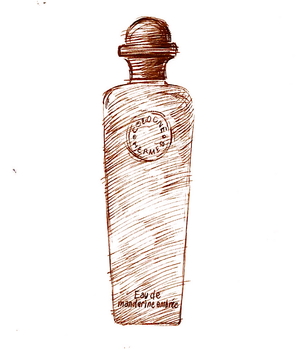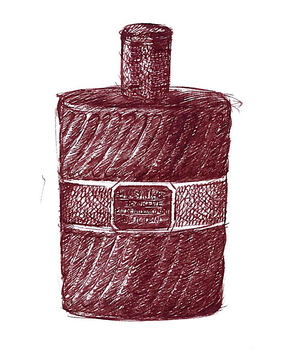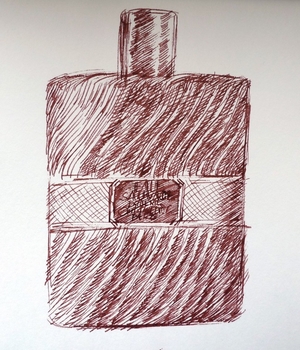Article Archive
Hermès
Equipage
14 July, 2014
 Equipage is a perfume I hadn’t smelled for years. I had a bottle long ago, but when it ran out I never got round to replacing it. Actually I’d forgotten how good it smells, so I’m delighted to have it back. It’s as timeless and well made as a piece of Hermès saddlery, and it even has something of the same comforting, leathery smell.
Equipage is a perfume I hadn’t smelled for years. I had a bottle long ago, but when it ran out I never got round to replacing it. Actually I’d forgotten how good it smells, so I’m delighted to have it back. It’s as timeless and well made as a piece of Hermès saddlery, and it even has something of the same comforting, leathery smell.
The first Hermès perfume to be aimed at men, Equipage was created by Guy Robert, one of the leading perfumers of his generation. You could say that Robert had perfume in his blood. He learned his trade in Grasse, once the world capital of perfumery and still an important production centre today. His uncle, Henri Robert, succeeded Ernest Beaux as perfumer-in-chief at Chanel, where he created No.19 and Pour Monsieur.
Equipage shares much of its character with Pour Monsieur, smelling effortlessly grown-up, discreet and rather conservative. The funniest comment I’ve seen online is that it ‘makes you smell ten years older. Richer, maybe; but older’, and I think that’s right, but now I’m older myself it’s nice to at least smell rich.
For a men’s perfume it has rather more floral ingredients than one might expect, including lily of the valley, jasmine and carnation, but they’re so subtly blended together that you’d never know. The flowers give it a little sweetness, but that’s balanced by the spicy, clove-scented edge of carnation. Equipage also contains a lot of orange, in the form of bergamot, squeezed from the peel of the Sicilian bergamot orange, Citrus bergamia, which is also used to flavour Earl Grey tea.
But that’s not all. This rich and complex fragrance also includes oakmoss (or a synthetic equivalent), which is actually a type of lichen that smells like a forest after rain; as it happens oakmoss also features in Pour Monsieur and Chanel No19. You might also be able to smell a touch of patchouli, that favourite 1970s fragrance, and perhaps a little Badedas-like pine – another forest touch.
There’s much, much more, which makes Equipage worth returning to again and again. It may not be the most avant-garde of fragrances, but if you want something reassuringly luxurious, it’s up there with the best.
Hermès
Eau de Mandarine Ambrée
1 June, 2014
 Now this is fun. Eau de Mandarine Ambrée isn’t perhaps the most sophisticated perfume in the world, but it’s a jolly, cheering little scent, that smells sweet and zesty and pretty much exactly like mandarin juice when you first spray it on. It was launched in 2013, at the same time as Eau de Narcisse Bleu, and brings the number of Hermès colognes up to five (the other three being Eau d’Orange Verte, Eau de Gentiane Blanche and Eau de Pamplemousse Rose).
Now this is fun. Eau de Mandarine Ambrée isn’t perhaps the most sophisticated perfume in the world, but it’s a jolly, cheering little scent, that smells sweet and zesty and pretty much exactly like mandarin juice when you first spray it on. It was launched in 2013, at the same time as Eau de Narcisse Bleu, and brings the number of Hermès colognes up to five (the other three being Eau d’Orange Verte, Eau de Gentiane Blanche and Eau de Pamplemousse Rose).
Like all the more recent Hermès perfumes it was created by Jean-Claude Ellena, whose celebrity status says much about how the industry has changed over the last decade or so – in the past no one would have known his name. His perfumes are nearly always interesting, if not always terrifically commercial, and Hermès seem to have given him licence (if you’ll forgive the pun) to follow his own nose and see where it takes him, especially with the colognes and it Hermessences range – see my review of Vétiver Tonka.
Ellena is very interested in food, and like quite a few of his perfumes, Eau de Mandarine Ambrée reminds me of cooking smells: nice cooking smells, that is. In this case it reminds me of the ugli-fruit marmalade that Roy made this year, which is very nice in its own way, but lacks the tartness of Seville-orange marmalade, and tastes a bit too sweet and jammy as a result.
Still, you could do far worse than start your day with Eau de Mandarine Ambrée. It’s light and refreshing and puts a smile on your face, yet it’s longer-lasting than most citrus-based colognes. This seems to be because Ellena has combined mandarin with a bit of passion-fruit extract and what’s known in the perfume trade as amber (thus Mandarine Ambrée).
‘Amber’ is one of those confusing terms that gives perfumery a bad name: it’s nothing to do with amber, the fossilised resin, or ambergris, the strange waxy lumps that whales occasionally cough up after swallowing too many cuttlefish (I kid you not), which develop a wonderful aroma only after bobbing around in the sea for a few years.
For perfumers, ‘amber’ refers to a careful blend of several ingredients, usually vanilla, benzoin and labdanum, which together give a sweet, slightly resinous and powdery smell. Ellena himself says that ‘I can think of no smell more joyful than mandarin, more mellow than amber,’ and I guess it’s the amber that helps Eau de Mandarine Ambrée last as long as it does.
Would I wear it a lot? Personally I prefer the sharper smells of colognes like Monsieur Balmain and Eau d’Orange Verte, but for anyone who likes something a bit sweeter and softer then Eau de Mandarine Ambrée would be a very happy choice.
Christian Dior
Eau Sauvage
3 March, 2014
 How did I get this far without reviewing Eau Sauvage? And now that I’ve finally got round to reviewing it, how am I going to do justice to such an iconic perfume? OK, I’ve covered Eau Sauvage Extrême, but that’s a dreary spin-off and bears little relation to the glorious real thing. So, deep breath now, and here we go.
How did I get this far without reviewing Eau Sauvage? And now that I’ve finally got round to reviewing it, how am I going to do justice to such an iconic perfume? OK, I’ve covered Eau Sauvage Extrême, but that’s a dreary spin-off and bears little relation to the glorious real thing. So, deep breath now, and here we go.
Created by the legendary perfumer Edmond Roudnitska, Eau Sauvage was launched in 1966, and it’s deservedly regarded as one of the greatest men’s perfumes of all. Roudnitska’s took the idea of a classic men’s cologne, packing it full of fresh, zingy, clean-smelling bergamot-orange oil from southern Italy, but then he did a brilliant thing, by blending it with an equally strong dose of a recently patented chemical called Hedione.
Hedione smells of jasmine – as well it might, since it was discovered by chemists during the process of deconstructing the molecular bits and bobs that, collectively, create natural jasmine’s heady, narcotic scent. Hedione’s real name is methyl dihydrojasmonate, and it was first isolated in 1958 by Dr Edouard Demole, who worked for the giant Swiss perfume company Firmenich.
Methyl dihydrojasmonate has a light jasmine smell but also something citrusy about it, giving Edmond Roudnitska a jigsaw piece that fitted into both the bergamot orange of a man’s cologne, and also had something – but crucially not too much – of natural jasmine’s sumptuous, powerfully floral scent, which most men would have considered far too feminine to wear.
To this Roudnitska added lavender – another floral scent, though this time one whose herby, faintly sweaty character had made it a long-standing male favourite – as well as a range of other, less pronounced ingredients including oakmoss (originally extracted from a lichen that smells of forests after rain) and patchouli, which in small amounts, I’m guessing, enhances the dandified character of Eau Sauvage without pushing it over into full-on let-it-all-hang-out hippiness.
A great perfume is one thing, and an all-too-rare thing at that, but it’s rarer still for a brilliant perfume to be supported by great marketing and presented in a great bottle. And here Eau Sauvage struck lucky again. Christian Dior died in 1957 of a heart attack, but under Yves Saint Laurent and then Marc Bohan, the company commissioned a series of sexy, tongue-in-cheek yet effortlessly elegant posters from René Gruau, arguably the greatest fashion illustrator of the 20th century. They certainly added to Eau Sauvage’s masculine appeal.
Few of us think a great deal about the bottles that contain the perfume we use, though they do have their collectors (most of whom, oddly, seem to have lost interest in the perfumes they contain). But some bottles repay a second glance, and Eau Sauvage is one of them. It was designed by Pierre Camin, who worked for Baccarat and created many of the bottles for the perfumer François Coty, and its chic silver cap, embossed with a pattern of tiny overlapping scales like a freshly-caught mackerel, is said to have been inspired by the silver thimble that Christian Dior always had to hand. The diagonally ridged sides of the bottle itself, meanwhile, are supposed to resemble the regular pleats of a Dior dress, though that seems a bit of a stretch to me.
I could go on, but in the unlikely event that you’ve never smelled Eau Sauvage, or think of it as a tired old dinosaur, I’d rather you headed out and tried it for yourself. Just be careful, though, as Dior have experimented with different versions over the years, and what’s now called Eau Sauvage Extrême (which you’d think would just be a stronger version, as indeed it used to be) is now a completely different fragrance, pleasant enough in a dull way but far less exciting than the original.
My last words, though, go to Edmond Roudnitska, not only because he was a perfumer of genius, but also because he also had something so important to say about marketing that it should be tattooed on the forehead of every perfume-company PR.
‘The choice of a perfume,’ he said, ‘can only rest on the competence acquired by education of olfactive taste, by intelligent curiosity and by a desire to understand the WHY and the HOW of perfume. Instead, the public [is] given inexactitudes and banalities. The proper role of publicity is to assist in the formation of connoisseurs, who are the only worthwhile propagandists for perfume, and it is up to the perfumers to enlighten, orient and direct the publicity agents.’
Here’s to the day his dream comes true.
Christian Dior
Eau Sauvage Extrême
20 July, 2012
 What have Dior done to Eau Sauvage Extrême? I started buying it when it was pretty much what it said on the bottle – a slightly more intense and much longer-lasting version of the original Eau Sauvage, with the original’s knockout sherbert lemon and jasmine combination cranked up several extra degrees. Not something you’d want to splash around too liberally, but fun on a dreary day.
What have Dior done to Eau Sauvage Extrême? I started buying it when it was pretty much what it said on the bottle – a slightly more intense and much longer-lasting version of the original Eau Sauvage, with the original’s knockout sherbert lemon and jasmine combination cranked up several extra degrees. Not something you’d want to splash around too liberally, but fun on a dreary day.
Eau Sauvage is a scent I love, not just for its superb intrinsic quality but also for its history as the first modern men’s fragrance to have a strongly floral character, cleverly disguised by the herbal and citrus elements of a classic cologne. It was also one of the first perfumes I ever wore, so there’s an element of nostalgia to my affection too.
So when the last bottle ran out it seemed only natural to buy another – except that when I next sprayed some on it was blatantly obvious that there was something missing: namely a huge hole where the lemony part of the formula should have been. Yes, Dior (or rather Firmenich or whichever fragrance company makes the scent for them) has taken the original and reformulated it, in one of those secretive, below-the-belt moves that give the industry such a bad name.
These kinds of underhand tricks go on all the time, but it’s particularly annoying when it happens to an iconic fragrance – and particularly stupid when what’s been taken out is the citrus element that makes Eau Sauvage such a distinctive perfume in the first place; without it it’s a muted, muffled thing, with about as much appeal as a piece of damp felt.
I’ve learned my lesson, but Dior obviously haven’t learned theirs.